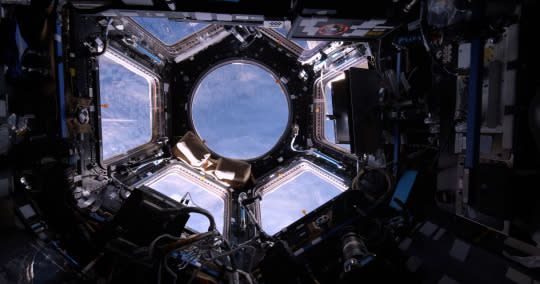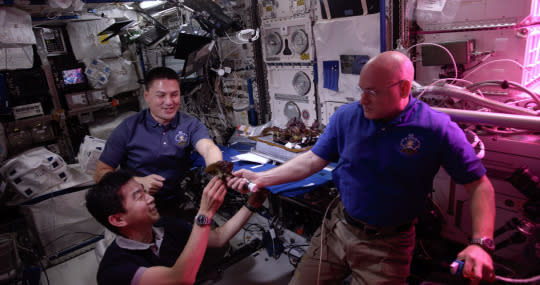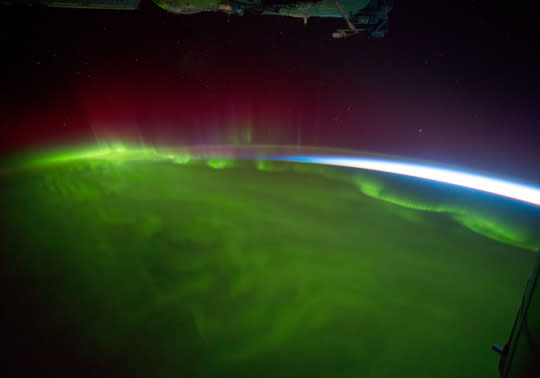‘A Beautiful Planet': friendly space station, muddled message

(Images courtesy IMAX)
NASA has a new documentary out, a humorous, heartwarming look at life on the International Space Station. The space agency has also just released an IMAX flick that turns a concerned gaze toward our planet and what we’re doing to it. You can see both for the price of one, because they’re the same movie.
A Beautiful Planet — NASA’s eighth collaboration with IMAX — performs one of those roles better than the other.
Still, if you’ve yet to attend one of NASA’s social-media meet-ups to hear astronauts talk about their work (and you should absolutely do so if you ever have a chance, especially if it’s one that involves a launch), then this 3-D movie narrated by Jennifer Lawrence and debuting April 29 may be the next best thing.
A home away from our home
Over the movie’s 46 minutes, crew members from Expeditions 42, 43, and 44 teach us that the ISS — big enough to see from the ground, continuously occupied by humans since Nov. 2, 2000 — is both a research facility and a home.
We see how astronauts and cosmonauts flood a narrow passageway to the airlock to hug new crews as they float from their Russian Soyuz capsule into the station. We hear the wistfulness in Barry “Butch” Wilmore’s voice as the NASA astronaut muses about boarding a Soyuz to return to Earth: “We are not going to have that fellowship with those people ever again.“
(Sadly, there are no shots of launches, something IMAX does exceedingly well.)
The movie, directed by Toni Myers, also effectively captures the untidiness of life in zero gravity. NASA’s Terry Virts describes the process of unloading cargo from a SpaceX Dragon as “organized bedlam” and relates how easily things float away: “We lost a 14-inch torque wrench for five weeks.”
Hilarity ensues when Wilmore has so much trouble wriggling out of his space suit that fellow astronaut Samantha Cristoforetti must float above him and push the suit away from him with her feet.
(Wilmore was at a reception that followed the screening I attended Friday at the National Air and Space Museum in Washington, so I could not resist inquiring if he’d ever felt like asking “Does this space suit make me look fat?” He laughed and replied that space suits make everybody look fat.)
We watch space travelers from the U.S., Russia, Europe and Japan exercise on a treadmill and on an industrial-looking contraption that helps that them do squats. We see the ISS’s menu enlivened by the delivery of an espresso machine and the successful cultivation of lettuce. And we get a quick overview of zero-G hair care. (Virts jokes about cutting Cristoforetti’s hair: “Of all the things we do as astronauts, this scares me the most.“)
The 3-D effects help make all this real, maybe too real. I felt a little queasy watching the first scenes onboard the ISS.

The view of here from up there
We also see the astronauts and cosmonauts looking out the window — a lot. As I’ve heard at least a dozen of them say, the view from the ISS — especially from the seven large windows of its Cupola module — is the most distracting thing about living off Earth. A Beautiful Planet treats us to such sights as the cities of Europe aglow at night (and in contrast, the near-total darkness of North Korea); the Caribbean’s shades of blue; and the green glow of the aurora borealis.
The most memorable view: the silent, explosive bursts of light inside clouds that mark lightning below. “You see power,” observes Virst.
ISS crewmembers also spy the damage that we have done to a planet (which, as Lawrence remarks in the movie’s opening sequence, is “the only place we know in all the universe to harbor life”).
Some of this damage — such as massive deforestation in Madagascar and Brazil — is visible from the ISS. Other insults — such as the the slow increase in the planet’s temperature caused by increasing levels of carbon dioxide and greenhouse gases — are less apparent, and here the movie struggles.
In these sections, Lawrence becomes the voice of doom, intoning that, “California’s reservoirs could soon be dry” and, “The city of New Orleans could be gone.”
More compelling testimony about the importance of not sitting on this slow-motion disaster comes from the astronauts themselves. Cristoforetti says that seeing the thinness of Earth’s atmosphere from above it forced her to see our planet as a spaceship itself.

But what, exactly, are we to do? Lawrence improbably suggests that the answer lies in adopting nuclear fusion, the unobtainium of power generation.
Look, I would like to see us use fusion for something besides thermonuclear weapons. But by the time we have that or any other miracle source of energy working reliably, we’ll either have braked climate change through other means or the Kennedy Space Center will have long since drowned along with much of the rest of Florida’s coastline.
And back on Earth, the bigger problem is that a large fraction of the American public remains militantly invested in denying human-caused climate change. The day after the screening, the Washington Post’s op-ed page featured a George Will column with this are-you-kidding-me serving of word salad, “Is change necessarily ominous because today’s climate is necessarily optimum?”
This movie alone won’t dent that level of denial. But what will?
Email Rob at rob@robpegoraro.com; follow him on Twitter at @robpegoraro.

